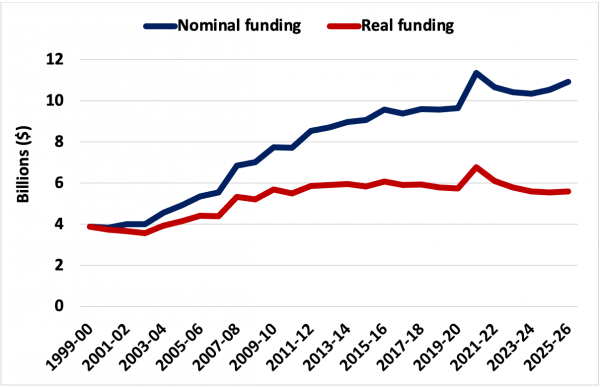The hits keep coming for higher education
Higher education has been one of the hardest-hit sectors in Australia’s economy during the pandemic. With international students prevented from coming to the country, universities suffered their first decline in revenue in over 8 years. The budget has now added insult to injury, committing to cut real funding to universities by 3.4% over the forward estimates (Figure 1). This decline in funding is mostly due to legislated cuts to Commonwealth Grant Scheme (which subsidises the cost of teaching students) under the Job Ready Graduate reform package which came into effect in January 2021.
Unfortunately, funding cuts are nothing new for higher education. Real funding for the sector has declined since the Coalition government was elected nine years ago. The sector has responded by becoming increasingly reliant on international student fees, casual employment, and the underpayment of staff – dysfunctions which were exacerbated by the pandemic.

In the 12 months to May 2021, Australian universities cut an estimated 35,000 staff, many of which were permanent. The loss of highly skilled and qualified educators, researchers, and professional staff, combined with the rising workloads for remaining workers, undermines the capacity of universities to provide this critical public service.
Even the new funding announced in the budget for higher education is in fact a double-edged sword. The government is providing $988.2 million over 5 years to increase ties between universities and the private sector through incentives for research commercialisation. This includes an Economic Accelerator grants program to support projects in areas including defence, space, resources, technology, food and beverages, clean energy and medical products. More funds will support PhD students deemed to be pursuing commercially attractive topics of study. While increasing collaboration between universities and business can be helpful, tying university funding so closely to commercial intertest raises troubling questions about the independence and integrity of university research.
Australia needs a higher education system that is ready and able to meet our future research and workforce needs. Instead, the government has used the budget as another opportunity to remove real resources from our public education and tighten corporate influence over the activities of our universities.
